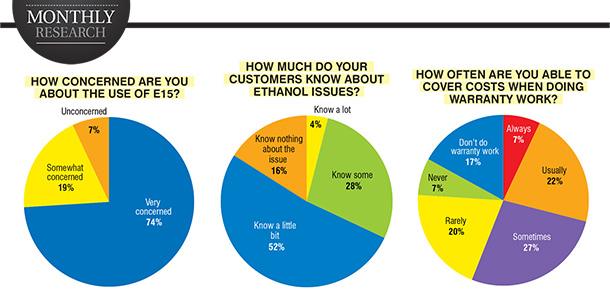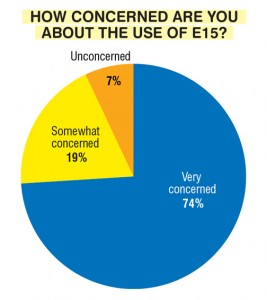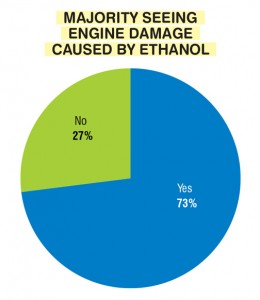Ethanol major repair issue

Significant factor in engine damage, survey says
Most marine businesses are experiencing engine damage and other issues due to ethanol in the fuel supply, raising increased concerns about the growing use of 15 percent ethanol blends (E15).
Boating Industry surveyed readers of our print and digital editions about service department and warranty issues, including ethanol, in April. Respondents were a mix of dealers, manufacturers, marina owners and others.
Damage widespread
 The vast majority of respondents reported seeing engine damage from ethanol, with 73 percent saying they’ve experienced it in their business. That number rises to 80 percent when we look at just dealers and marina/boatyard owners.
The vast majority of respondents reported seeing engine damage from ethanol, with 73 percent saying they’ve experienced it in their business. That number rises to 80 percent when we look at just dealers and marina/boatyard owners.
And it’s not a small portion of the engine work they’re seeing, either. Of those that have seen ethanol damage in their business, 14 percent say ethanol is responsible for more than half of the engine repairs they make. More than 60 percent say it causes more than 20 percent of the engine damage they experience.
“It is the cause of much of our regular service work,” said an Ohio marina owner. “De-laminated fuel lines, deteriorating fuel lines … corrosion in carb bowls, fuel tanks and VST tanks.”
 Said a North Carolina boatyard owner: “If an older engine comes in for repair, or has been sitting a while, it always has fuel problems due to ethanol.”
Said a North Carolina boatyard owner: “If an older engine comes in for repair, or has been sitting a while, it always has fuel problems due to ethanol.”
While many marinas carry ethanol-free fuel, many consumers fill up at roadside stations – about two-thirds, a recent survey of BoatUS members found. At most stations, that is a 10 percent ethanol blend. That’s a level of ethanol that new engines can handle if run and cared for properly, but that does nothing about the large number of legacy engines out there.
Education a key concern
Now with E15 on the horizon, there is even more reason for concern. While not widely available across most of the country, it is spreading, especially in the Midwest. And that is a major area of concern for the respondents to our survey.
 Nearly 75 percent are very concerned about the use of E15 in the fuel supply and 93 percent described themselves as at least somewhat concerned. Only 7 percent aren’t worried about it.
Nearly 75 percent are very concerned about the use of E15 in the fuel supply and 93 percent described themselves as at least somewhat concerned. Only 7 percent aren’t worried about it.
Most of our readers consider themselves fairly well informed about the potential damage and other issues surrounding ethanol. Fifty-four percent said they know a lot about the issue; an additional 39 percent said they know some. About 6 percent said they know a little and 1 percent said they know nothing about it.
It’s worth noting that the more readers know about ethanol, the more worried they are about it. Of those who said they know a lot, 88 percent are very concerned about it, 97 percent are at least somewhat concerned and only 3 percent are not concerned. For those that know some information about ethanol, 67 percent are very concerned, 96 percent are somewhat concerned and 4 percent are not concerned. Finally, for those who know a little or nothing about ethanol, only 14 percent are very concerned, 46 percent are somewhat concerned and 40 percent are not concerned.
 Despite their own level of knowledge, respondents don’t think their customers are well-informed about the issue. Only 4 percent think their customers know a lot, while only 28 percent know some about ethanol’s potential to damage engines. Fifty-two percent think they know a little bit, while 16 percent said their customers know nothing about ethanol.
Despite their own level of knowledge, respondents don’t think their customers are well-informed about the issue. Only 4 percent think their customers know a lot, while only 28 percent know some about ethanol’s potential to damage engines. Fifty-two percent think they know a little bit, while 16 percent said their customers know nothing about ethanol.
“We go to extreme lengths to educate new engine owners and even make them sign a paper that we discussed it and they understand their warranty does not cover fuel-related damages,” said a Missouri boat dealer.
That lack of knowledge can often lead to more issues when buyers feel the dealer or manufacturer is not standing behind their product.
“When boaters (particularly those with 2010 and older boats) have a problem they blame the boat and or motor manufacturer and the dealer,” said a Texas boat dealer. “Ethanol and the typical expensive repairs are causing considerable damage to the enjoyment of boating for many participants.”
Warranty work a challenge
While not related to ethanol directly, we also asked readers about their experience with warranty claims in the survey.
Overall, the majority of respondents — 64 percent — said they haven’t seen a change in warranty claims over the last year. Twenty-two percent said they are seeing more warranty claims and 14 percent said they are seeing fewer.
Making the necessary margins on warranty work has been a common complaint for years and continues to be an issue in some cases.
Of those dealers, marinas and boatyards that perform warranty work, only 10 percent said they can always cover their costs. Another 28 percent said they can usually do so and 29 percent said that is sometimes the case. Twenty-six percent said they can rarely cover costs, while 7 percent said they never can.





. Ethanol
Been in business over 30 years. Ethanol has caused more damage than
Anything I’ve seen. Why have most rubber products had to be changed
To accommodate this product. Why do we put this product in our expensive
Boats, then have to put more expensive,ethanol treatment in to protect our
Boats. Why was ethanol developed anyway. It has driven up food prices.
What s about using natural gas. Be fairly inexpensive to convert to.
My honest opinion? If Brunswick, BRP, Volvo Penta, Yamaha, Suzuki, Honda, Tohatsu…FORD…GM…CHRYSLER…HONDA…TOYOTA..and every OEM Manufacture was serious and told the Federal Gov that they would not sell their products to US consumers because of the SHIT ethanol fuels…what do you think would happen?…..THEY ARE DOING NOTHING BECAUSE THEY DONT CARE…AND THEY ARE MAKING MONEY OFF ALL THE NON WARRANTY REPAIRS. Us as dealers? Why should we care? We are making tons of money. As usual the consumer gets the shaft….Thank you Federal Gov!